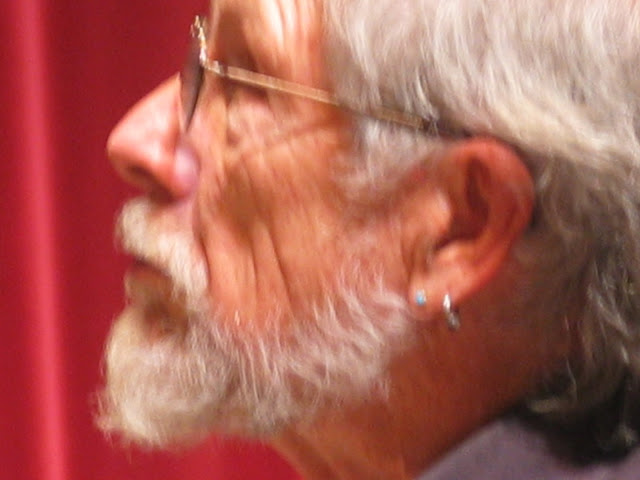Interview by Christian Martin
Robert Michael Pyle has been interpreting the natural world for
readers for more than 30 years. Combining his Yale-educated scientific background,
an insatiable curiosity for the world and a warm, generous personality that inspires
his prose, Pyle explores the myriad ways in which nature intersects with our
daily lives.
A long-time resident of Grays River in southwestern Washington,
Pyle’s published work—which includes books on the natural history of the Willapa
Hills, Bigfoot, butterflies, Vladimir Nabokov and his childhood in Colorado—
has been recognized with two Washington State Book Awards, a National Outdoor
Book Award, a Guggenheim Fellowship and the John Burroughs Medal for
Distinguished Nature Writing.
His latest book The Tangled
Bank collects dozens of his columns from when he was a regular contributor
to Orion and Orion Afield magazines. Each personable piece is a finely honed
mini-essay, weaving together natural history, philosophical ruminations,
travelogue, scientific facts, poetic observations and commentary on
contemporary culture.
CM: Your column “The Tangled Bank” was published in 52 consecutive issues
of Orion over 11 years. What were the
challenges in writing such a long-standing feature with a strict format?
RMP: The
biggest challenge was to learn to write concisely (750–1300 words, depending on
the issue) and still write substantively, not lite, shallow or “sound-bitey.” I
did enjoy it, and continue to value and employ the heavy apprenticeship in
concision that it represented. But it was invariably difficult, sometimes
wrenchingly so, to meet the inflexible word counts and the incessant deadlines.
It seemed that no matter how long and how many drafts a column took to finish,
there was always the next one due on its heels. But that's good, too, to keep
you going.
CM: How did you come up with
enough topics to sustain the column?
RMP: I wrote about what most fascinated me at the time. Since I am
always fascinated with something, or many things, and since my travels constantly
suggest new topics, it wasn't difficult. The greater difficulty was deciding
among the many possible topics. This collection of my columns concludes with a
list of 52 more I'd like to write someday, including ones on waterbears, plants
that grow on animals, the evolution of empathy, recycling roadkill, the history
of saffron and the ontology of crocuses and “Utopia: what to leave in, what to
leave out.” I could go on.
CM: Was there a unifying theme or mission that tied together the columns
over the years?
RMP: Yes, the unifying theme was Darwin's contention that "it
is interesting to contemplate a tangled bank...”—in other words, all of nature is interesting when
closely observed. My mission was to demonstrate that the world is never boring.
And, I suppose you could say, to dive as deeply as I could in one breath.
CM: It is very unusual to find natural history writing, as exemplified
in these columns, in publications today, don't you think?
RMP: Yes, such writing is rare, especially with a bit of wit, which
I employed when appropriate. One does see good natural history writing here and
there in serials, such as Tom Titus's fine essays in the newsletter of the
Eugene Natural History Society and Rod Crawford's columns on spider collecting
expeditions in Scarabogram. But not a lot. Maybe there are lots of good
naturalists’ blogs, but since I don't tend to read online, I don't see them. I
mostly go to books, both fiction and nonfiction, and of course, poetry.
Apart from the obvious candidates we both know and love, some
current writers of excellent natural history (writ large and sometimes funny)
that I would endorse include Ken Lamberton, David Carroll, Julia Whitty, Jim
Lynch, Charles Goodrich, Bill Yake, Seth Kantner, Carl Hiasson, Barbara
Kingsolver, Henry Hughes...these are people who observe the world in all its
individuating detail and bring it back in ways that delight me.
CM: Your column succeeded in connecting natural history and
scientific topics to contemporary life and relevant issues.
RMP: It keeps the wide world always engaging—and therefore, ever
compensatory—for the unsatisfactory qualities of the narrow world of human
society. Ala Robinson Jeffers, it can help you keep your mind in
maddening times. It makes life, in short, more fun.
CM: What do you do to keep the arts of traditional natural history
studies alive?
RMP: I go out of doors, with my eyes, ears, and mind wide open. And
then, when and if I feel like it, I write about it, in letter, journal, essay,
poem, or even—if nothing else—an email. Other than that, I guess my main ways
of helping to keep the practice alive are the reading and writing of books informed
by the physical world; and urging the young to go afield, to seek, to read,
and—if they feel so moved—to write what they find.
Photo by Benj Drummond: bdsjs.com.























